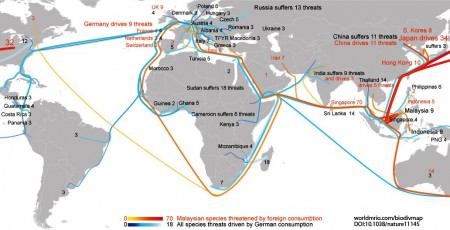- What is the best beef in Europe?
- When was the first yoghurt of the Neolithic?
- How do you measure smallholder resilience? Or vulnerability, for that matter…
- How does this Kenyan seed story differ from this Malian one?
- How do you address iron deficiency in Rwanda?
- What’s the value of a genebank?
- There’s a downside to plant-derived smoke?
- So what’s the latest paradigm shift on that ancient-people-in-the-Amazon thing?
- How are the Spanish people coping with the crisis?
- How come those transcribed podcasting, medal winning conservationists still don’t get it?
- What are Ethiopians doing in Amazonia?
Nibbles: MCPD, Coffee pollination, WACCI & IITA get into bed, Quinoa value addition, Plant chemicals
- Rejoice, the new edition of the FAO/Bioversity Multi-Crop Passport Descriptors (MCPD) are now available on-line!
- Pollinators good for pollination shock. No, kidding apart, this is Pollinator Week and we should take note.
- Another step in building plant breeding capacity in West Africa.
- How to get quinoa cake on the menu of posh Bolivian coffee shops.
- Virtual tour of my old stomping ground at the Cambridge University Botanical Garden includes a chemical trail. Which alas does not in turn include the main chemical we used to consume there.
Nibbles: ITPGRFA, Samoan coconuts, Ancient Amazon, Moringa
- CGIAR pushes ITPGRFA into Rio +20 limelight. ITPGRFA unavailable for comment.
- Recession or no recession, Samoan women’s group in Body Shop coconut oil deal.
- Pre-Columbian Amazon not densely inhabited after all. Just wake me up when they sort this out.
- Ok, where do I get my hands on some Moringa leaves?
Markets in everything, food security edition
I know, I know, there’s been much more talk about market failure in the past couple of years than about market success. Case in point: a clever interactive map has been done showing you where markets have been bad for biodiversity, but not one showing where they’ve been good.
But all that negativity hasn’t stopped Dougal Thomson just launching a discussion on what the private sector can do for food security. It’s all to get you interested in The Economist’s Feeding the World conferences later this year of course. And to put you in an appropriately market-friendly mood for Rio +20 next week too, I suppose.
Anyway, here’s where, recession or no recession, you can channel your inner capitalist and tell the world how to “…reconcile a multinational’s need for profit with a smallholder’s need for income, a mother’s need to feed her baby and a nation’s need for food security.”
Following threats to animals along supply chains
As Rio +20 looms ever nearer, everyone is scrambling to put stuff out pushing their particular agenda, taking care to note that they’re not suggesting that their agenda is any less vital than anyone else’s agenda, of course, and that in any case There Are No Silver Bullets. One of the more interesting products released to coincide with next week’s Brazilian festivities is an interactive map which uses “a new global trade database to follow the products implicated in species threats right through to the final consumers.”
The paper describing the methodology is in Nature.
We linked 25,000 Animalia species threat records from the IUCN Red List of endangered species to over 15,000 commodities produced in 187 countries. We then used the trade database to evaluate over 5 billion supply chains in terms of their biodiversity impacts.
It’s a massive undertaking, and it may be churlish to wonders why it’s not easier to export the maps it enables one to produce. So I won’t, and merely confine myself to hoping that a plant version will be available soon. Oh, and maybe also one in which agriculture is not seen only as the bad guy. In fact, would it not be nice to have the other side of the coin? That is, a map showing where supply chains may actually be contributing to conservation. Come on, there must be a few examples of that! Bird-friendly coffee, anyone?
